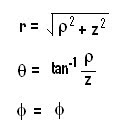Spherical Coordinate System (r, θ, φ) - Field Theory
Geographers specify a location on the Earth’s surface using three scalar values:
longitude, latitude, and altitude.
Both longitude and latitude are angular measures, while altitude is a measure of distance.
Latitude, longitude, and altitude are similar to Spherical Co-ordinates.
Spherical coordinates consist of one scalar value (r), with units of distance, while the other two scalar values (θ, φ) have angular units (degrees or radians).
A Vector in Spherical System is represented as
(Ar Aθ, Aφ)
or
A = Arar + Aθaθ + Aφaφ
Where ar, aθ and aφ are the unit vectors in r, θ and φ direction respectively.
The physical significance of each parameter of spherical coordinates:
- The value r expresses the distance of the point from origin (i.e. similar to altitude). It is the radius of the sphere.
- The angle θ is the angle formed with the z- axis (i.e. similar to latitude). It is also called the co-latitude angle. It is measured clockwise.
- The angle φ, also called the azimuthal angle, indicates the rotation angle around the z-axis (i.e. similar to longitude). It is basically measured from the x axis in the x-y plane. It is measured counter-clockwise.
Range of the variables:
It defines the minimum and the maximum value that r, θ and φ can have in spherical co-ordinate system.
- 0 ≤ r ≤ ∞
 - 0 ≤ θ ≤ π
- 0 ≤ θ ≤ π- 0 ≤ φ ≤ 2π
Spherical System - Unit Vectors:
Since the co-ordinate system is orthogonal, the unit vectors
ar, aθ and aφ are mutually perpendicular to each other.
- ar points in the direction of increasing r i.e.
ar points away from the z-axis.
- aθ points in the direction of increasing θ.
- aφ points in the direction of increasing φ.
Consider the parallelogram ABOC,
- X = ρcos φ.
- Y = ρsin φ.
 - Z = Z.
- Z = Z.Consider the second parallelogram OCPQ, we have
- ρ = r sin θ
- z = r cos θ
So from the above data available we can say,
- x = r sin θ cos φ.
- Y = r sin θ sin φ.
- Z = r cos θ.
Similarly relationship between spherical and cylindrical coordinates can be derived as:
Relationship between (ax, ay, az) and (ar, aθ, aφ)
From the cylindrical coordinate system we know that,
ax = cosφ aρ – sinφ aφ
ay = sinφ aρ + cosφ aφ
az = az
From the above figure, we can write aρ in terms of ar and aθ as
aρ = cos (90o – θ) ar + cos θ aθ
az = cos θ ar - sin θ aθ
Hence the unit vectors of cartesian and spherical co-ordinate system are related as:
ax = sin θ cos φ ar + cos θ cos φ aθ - sin φ aφ
ay = sin θ sin φ ar + cos θ sin φ aθ + cos φ aφ
az = cos θ ar - sin θ aθ
Transformation of vector A from (Ar, Aθ, AФ) to (Ax, Ay, Az) i.e. transformation of Vector A from Spherical to Cartesian can be obtained as

Transformation of vector A from (Ax, Ay, Az) to (Ar, Aθ, AФ) i.e. transformation of Vector A from Cartesian to Spherical can be obtained as

SOLVED EXAMPLE / NUMERICALS:
Q.2. Express the point P (1, -4, -3) in cylindrical and spherical co-ordinates? SOLUTION/ANSWER
Q.3
a) If V = XZ – XY +YZ, express V in Cylindrical co-ordinate system.
b) If U = X2 + 2Y2 +3z2, express U in Spherical co- ordinates System. SOLUTION/ANSWER
Q.4 Transform the vector E = (y2 – x2) ax + xyz ay + (x2 – z2) ax to cylindrical and spherical system? SOLUTION/ANSWER
Q.5 Express the vector A = ρ (z2 + 1)aρ - ρz cosφaφ in Cartesian co-ordinate system? SOLUTION/ANSWER
Q.6 Express the vector E =2r sinθ cosφar + r cosθ cosφaθ – r sinφaφ in Cartesian co-ordinate system?SOLUTION/ANSWER
Q.7 Calculate the distance between the following pair of points?
a) (2, 1, 5) and (6, -1, 2)
b) (3, π/2, -1) and (5, 3π/2, 5)
c) (10, π/4, 3π/4) and (5, π/6, 7π/4) SOLUTION/ANSWER
ALSO READ:
- Introduction To Coordinate System.
- Cartesian Coordinate System / Rectangular Coordinate System (x, y, z).
- Differential Analysis Of Cartesian Coordinate System.
- Circular Cylindrical Coordinate System (ρ, φ, z).
- Differential Analysis Of Cylindrical Coordinate System.
- Spherical Coordinate System ( r, θ , φ).
- Differential Analysis Of Spherical Coordinate System.
- Numericals / Solved Examples - Page 1.
- Numericals / Solved Examples - Page 2.
Your suggestions and comments are welcome in this section. If you want to share something or if you have some stuff of your own, please do post them in the comments section.





I've been looking for a quick explanation. Thanks!
ReplyDelete